Article Critique: The Effect of Motivation on Workplace Performance
VerifiedAdded on 2020/04/07
|9
|2140
|152
Report
AI Summary
This report provides a thorough critique of an article titled "The Effect of the Motivation Techniques Used by Managers to Increase the Productivity of their Workers and an Application." The critique evaluates the article's strengths and weaknesses, including its discussion of various motivation techniques such as job enrichment, business enlargement, and brainstorming. It also examines the factors that reduce efficiency, like poor working environments and negative employee relations. The report assesses the research methods, sample size, and data collection techniques used in the original study. The critique acknowledges the article's valuable insights into the importance of motivation for workplace productivity while also pointing out some of the article's limitations, such as the lack of updated references and potential biases in the study. The report concludes by emphasizing the relevance of the study's findings to current organizational practices and offering suggestions for future research.
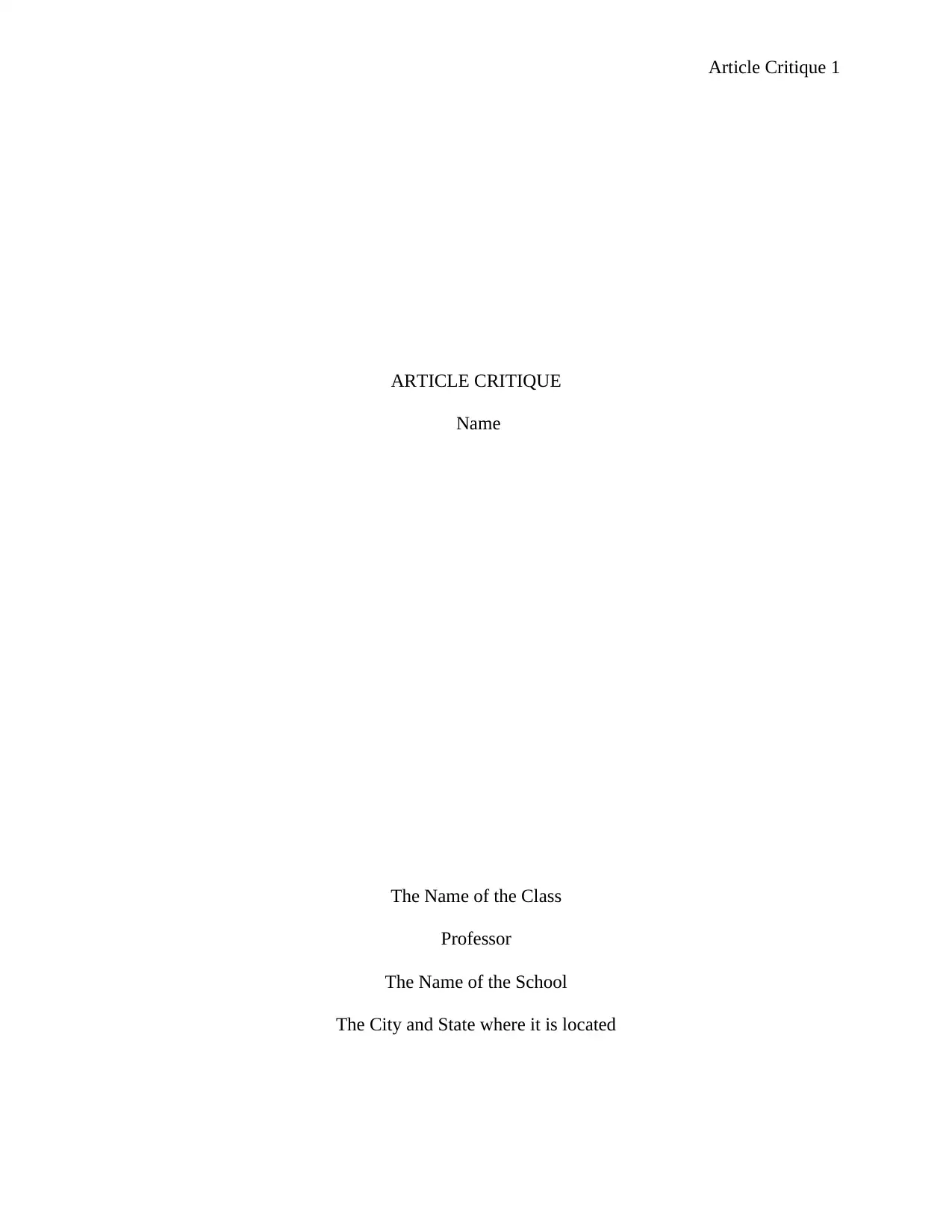
Article Critique 1
ARTICLE CRITIQUE
Name
The Name of the Class
Professor
The Name of the School
The City and State where it is located
ARTICLE CRITIQUE
Name
The Name of the Class
Professor
The Name of the School
The City and State where it is located
Secure Best Marks with AI Grader
Need help grading? Try our AI Grader for instant feedback on your assignments.
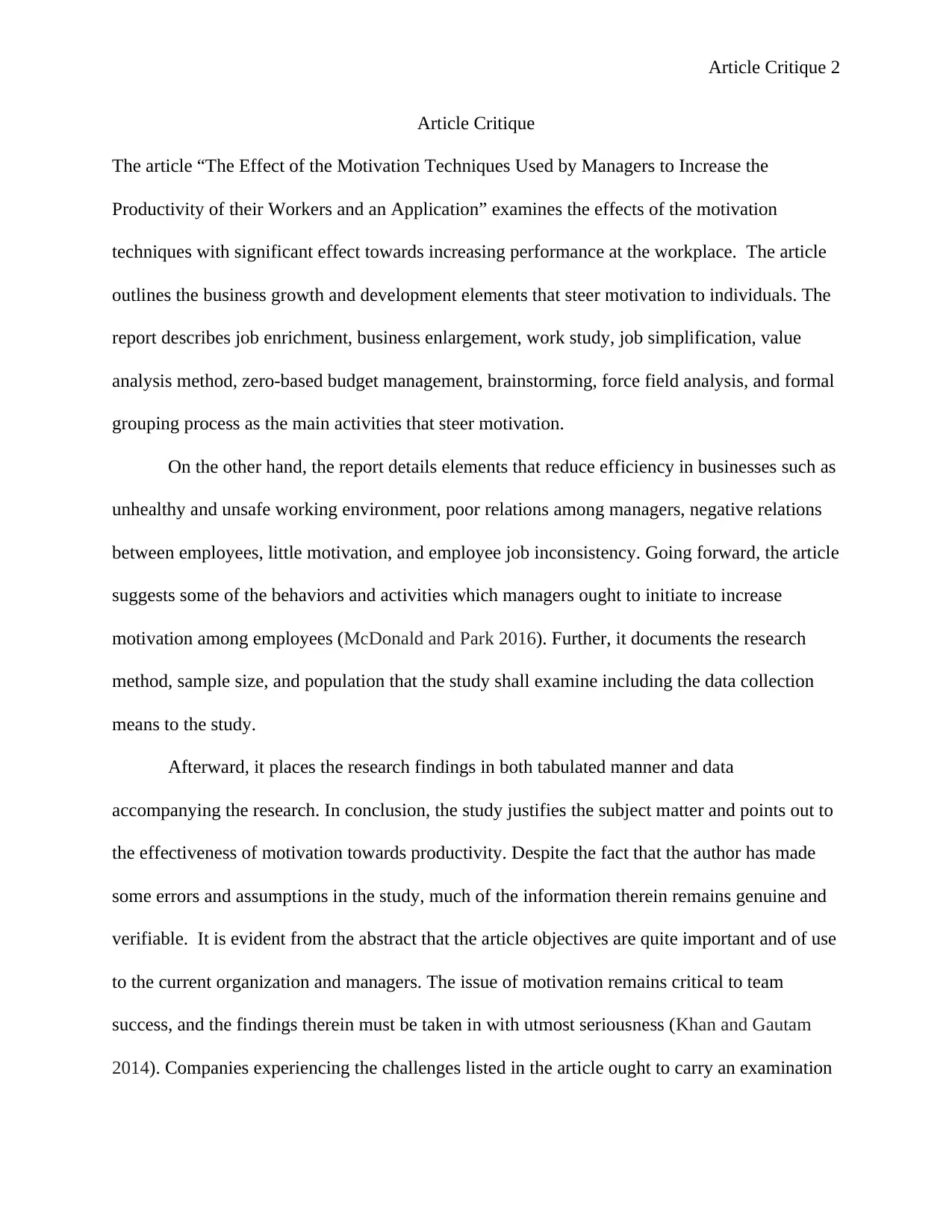
Article Critique 2
Article Critique
The article “The Effect of the Motivation Techniques Used by Managers to Increase the
Productivity of their Workers and an Application” examines the effects of the motivation
techniques with significant effect towards increasing performance at the workplace. The article
outlines the business growth and development elements that steer motivation to individuals. The
report describes job enrichment, business enlargement, work study, job simplification, value
analysis method, zero-based budget management, brainstorming, force field analysis, and formal
grouping process as the main activities that steer motivation.
On the other hand, the report details elements that reduce efficiency in businesses such as
unhealthy and unsafe working environment, poor relations among managers, negative relations
between employees, little motivation, and employee job inconsistency. Going forward, the article
suggests some of the behaviors and activities which managers ought to initiate to increase
motivation among employees (McDonald and Park 2016). Further, it documents the research
method, sample size, and population that the study shall examine including the data collection
means to the study.
Afterward, it places the research findings in both tabulated manner and data
accompanying the research. In conclusion, the study justifies the subject matter and points out to
the effectiveness of motivation towards productivity. Despite the fact that the author has made
some errors and assumptions in the study, much of the information therein remains genuine and
verifiable. It is evident from the abstract that the article objectives are quite important and of use
to the current organization and managers. The issue of motivation remains critical to team
success, and the findings therein must be taken in with utmost seriousness (Khan and Gautam
2014). Companies experiencing the challenges listed in the article ought to carry an examination
Article Critique
The article “The Effect of the Motivation Techniques Used by Managers to Increase the
Productivity of their Workers and an Application” examines the effects of the motivation
techniques with significant effect towards increasing performance at the workplace. The article
outlines the business growth and development elements that steer motivation to individuals. The
report describes job enrichment, business enlargement, work study, job simplification, value
analysis method, zero-based budget management, brainstorming, force field analysis, and formal
grouping process as the main activities that steer motivation.
On the other hand, the report details elements that reduce efficiency in businesses such as
unhealthy and unsafe working environment, poor relations among managers, negative relations
between employees, little motivation, and employee job inconsistency. Going forward, the article
suggests some of the behaviors and activities which managers ought to initiate to increase
motivation among employees (McDonald and Park 2016). Further, it documents the research
method, sample size, and population that the study shall examine including the data collection
means to the study.
Afterward, it places the research findings in both tabulated manner and data
accompanying the research. In conclusion, the study justifies the subject matter and points out to
the effectiveness of motivation towards productivity. Despite the fact that the author has made
some errors and assumptions in the study, much of the information therein remains genuine and
verifiable. It is evident from the abstract that the article objectives are quite important and of use
to the current organization and managers. The issue of motivation remains critical to team
success, and the findings therein must be taken in with utmost seriousness (Khan and Gautam
2014). Companies experiencing the challenges listed in the article ought to carry an examination
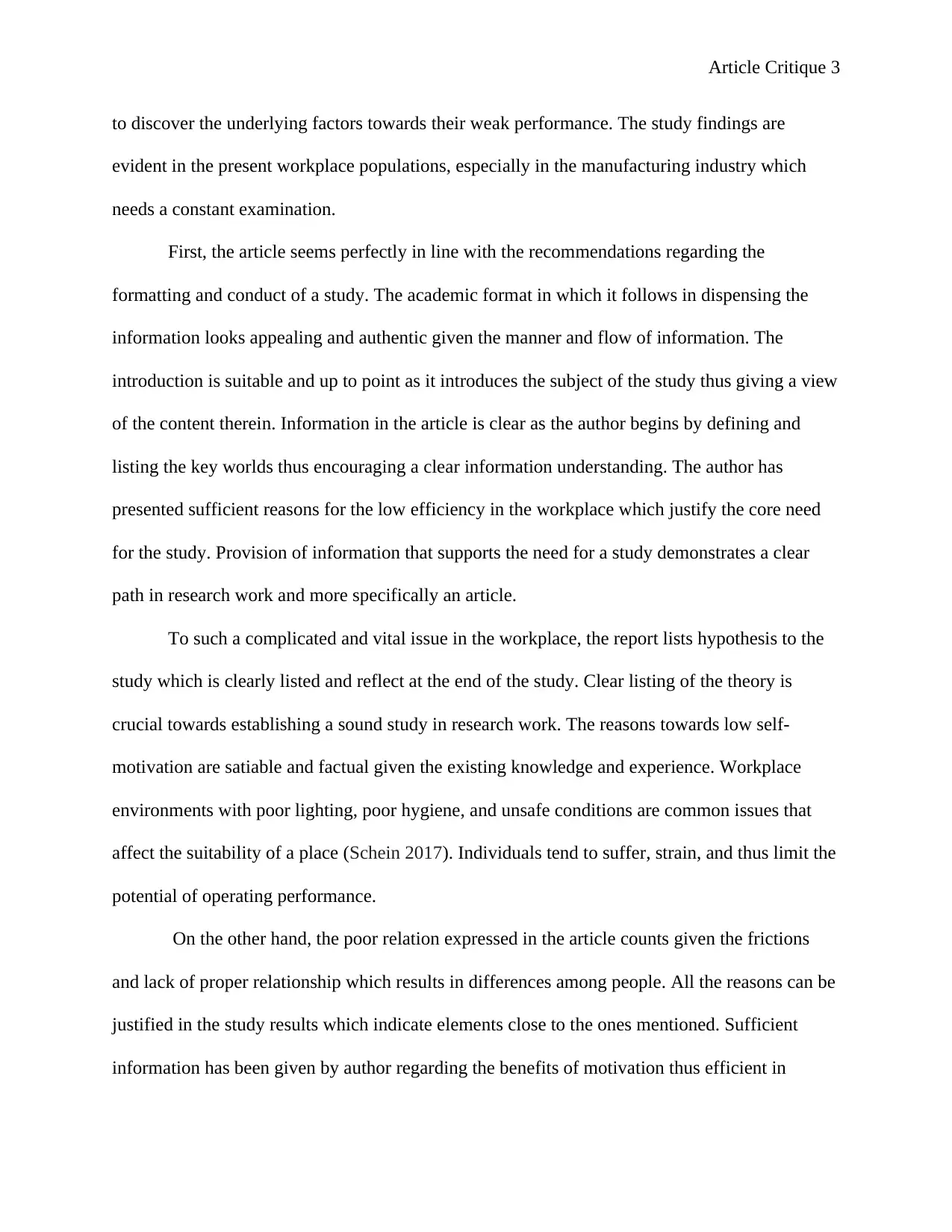
Article Critique 3
to discover the underlying factors towards their weak performance. The study findings are
evident in the present workplace populations, especially in the manufacturing industry which
needs a constant examination.
First, the article seems perfectly in line with the recommendations regarding the
formatting and conduct of a study. The academic format in which it follows in dispensing the
information looks appealing and authentic given the manner and flow of information. The
introduction is suitable and up to point as it introduces the subject of the study thus giving a view
of the content therein. Information in the article is clear as the author begins by defining and
listing the key worlds thus encouraging a clear information understanding. The author has
presented sufficient reasons for the low efficiency in the workplace which justify the core need
for the study. Provision of information that supports the need for a study demonstrates a clear
path in research work and more specifically an article.
To such a complicated and vital issue in the workplace, the report lists hypothesis to the
study which is clearly listed and reflect at the end of the study. Clear listing of the theory is
crucial towards establishing a sound study in research work. The reasons towards low self-
motivation are satiable and factual given the existing knowledge and experience. Workplace
environments with poor lighting, poor hygiene, and unsafe conditions are common issues that
affect the suitability of a place (Schein 2017). Individuals tend to suffer, strain, and thus limit the
potential of operating performance.
On the other hand, the poor relation expressed in the article counts given the frictions
and lack of proper relationship which results in differences among people. All the reasons can be
justified in the study results which indicate elements close to the ones mentioned. Sufficient
information has been given by author regarding the benefits of motivation thus efficient in
to discover the underlying factors towards their weak performance. The study findings are
evident in the present workplace populations, especially in the manufacturing industry which
needs a constant examination.
First, the article seems perfectly in line with the recommendations regarding the
formatting and conduct of a study. The academic format in which it follows in dispensing the
information looks appealing and authentic given the manner and flow of information. The
introduction is suitable and up to point as it introduces the subject of the study thus giving a view
of the content therein. Information in the article is clear as the author begins by defining and
listing the key worlds thus encouraging a clear information understanding. The author has
presented sufficient reasons for the low efficiency in the workplace which justify the core need
for the study. Provision of information that supports the need for a study demonstrates a clear
path in research work and more specifically an article.
To such a complicated and vital issue in the workplace, the report lists hypothesis to the
study which is clearly listed and reflect at the end of the study. Clear listing of the theory is
crucial towards establishing a sound study in research work. The reasons towards low self-
motivation are satiable and factual given the existing knowledge and experience. Workplace
environments with poor lighting, poor hygiene, and unsafe conditions are common issues that
affect the suitability of a place (Schein 2017). Individuals tend to suffer, strain, and thus limit the
potential of operating performance.
On the other hand, the poor relation expressed in the article counts given the frictions
and lack of proper relationship which results in differences among people. All the reasons can be
justified in the study results which indicate elements close to the ones mentioned. Sufficient
information has been given by author regarding the benefits of motivation thus efficient in
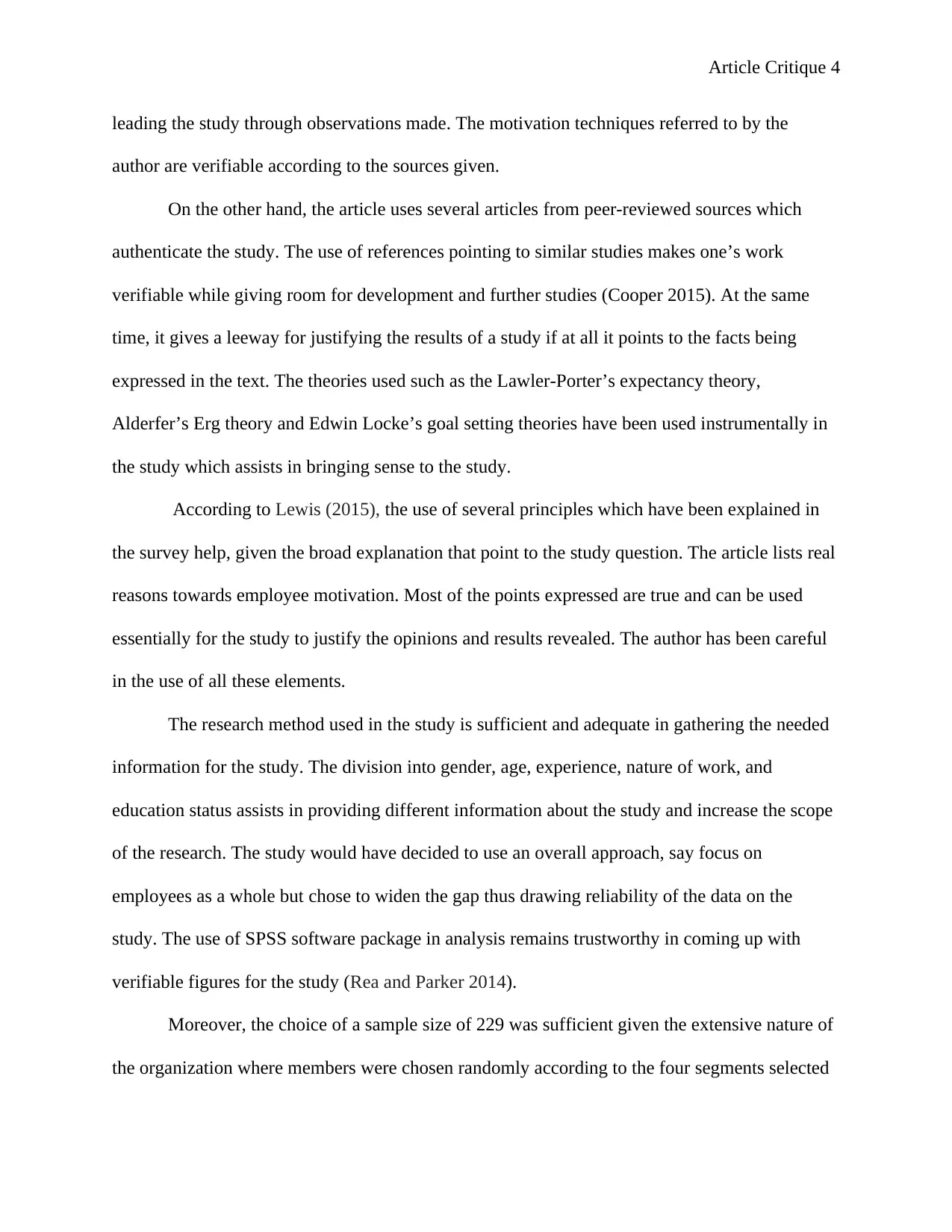
Article Critique 4
leading the study through observations made. The motivation techniques referred to by the
author are verifiable according to the sources given.
On the other hand, the article uses several articles from peer-reviewed sources which
authenticate the study. The use of references pointing to similar studies makes one’s work
verifiable while giving room for development and further studies (Cooper 2015). At the same
time, it gives a leeway for justifying the results of a study if at all it points to the facts being
expressed in the text. The theories used such as the Lawler-Porter’s expectancy theory,
Alderfer’s Erg theory and Edwin Locke’s goal setting theories have been used instrumentally in
the study which assists in bringing sense to the study.
According to Lewis (2015), the use of several principles which have been explained in
the survey help, given the broad explanation that point to the study question. The article lists real
reasons towards employee motivation. Most of the points expressed are true and can be used
essentially for the study to justify the opinions and results revealed. The author has been careful
in the use of all these elements.
The research method used in the study is sufficient and adequate in gathering the needed
information for the study. The division into gender, age, experience, nature of work, and
education status assists in providing different information about the study and increase the scope
of the research. The study would have decided to use an overall approach, say focus on
employees as a whole but chose to widen the gap thus drawing reliability of the data on the
study. The use of SPSS software package in analysis remains trustworthy in coming up with
verifiable figures for the study (Rea and Parker 2014).
Moreover, the choice of a sample size of 229 was sufficient given the extensive nature of
the organization where members were chosen randomly according to the four segments selected
leading the study through observations made. The motivation techniques referred to by the
author are verifiable according to the sources given.
On the other hand, the article uses several articles from peer-reviewed sources which
authenticate the study. The use of references pointing to similar studies makes one’s work
verifiable while giving room for development and further studies (Cooper 2015). At the same
time, it gives a leeway for justifying the results of a study if at all it points to the facts being
expressed in the text. The theories used such as the Lawler-Porter’s expectancy theory,
Alderfer’s Erg theory and Edwin Locke’s goal setting theories have been used instrumentally in
the study which assists in bringing sense to the study.
According to Lewis (2015), the use of several principles which have been explained in
the survey help, given the broad explanation that point to the study question. The article lists real
reasons towards employee motivation. Most of the points expressed are true and can be used
essentially for the study to justify the opinions and results revealed. The author has been careful
in the use of all these elements.
The research method used in the study is sufficient and adequate in gathering the needed
information for the study. The division into gender, age, experience, nature of work, and
education status assists in providing different information about the study and increase the scope
of the research. The study would have decided to use an overall approach, say focus on
employees as a whole but chose to widen the gap thus drawing reliability of the data on the
study. The use of SPSS software package in analysis remains trustworthy in coming up with
verifiable figures for the study (Rea and Parker 2014).
Moreover, the choice of a sample size of 229 was sufficient given the extensive nature of
the organization where members were chosen randomly according to the four segments selected
Secure Best Marks with AI Grader
Need help grading? Try our AI Grader for instant feedback on your assignments.
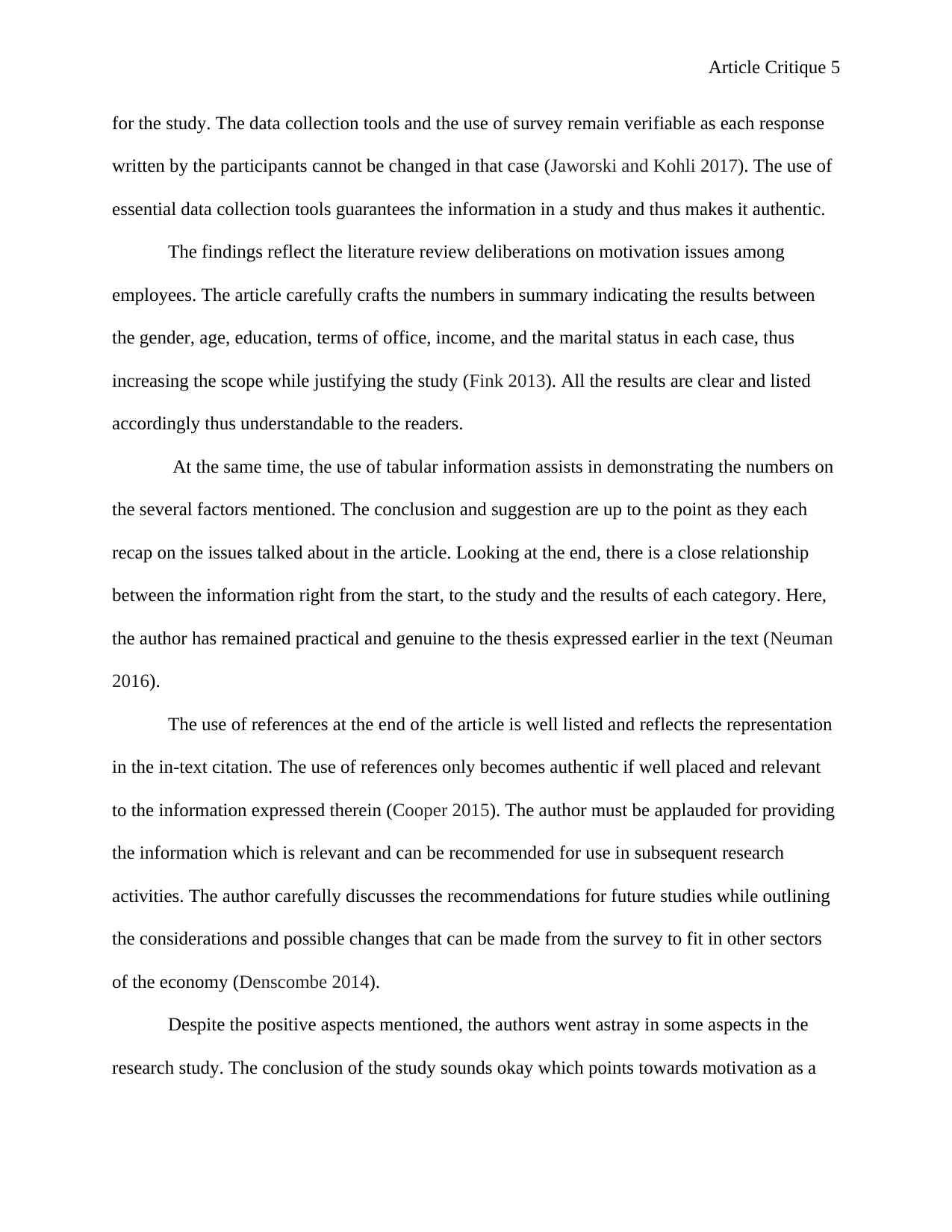
Article Critique 5
for the study. The data collection tools and the use of survey remain verifiable as each response
written by the participants cannot be changed in that case (Jaworski and Kohli 2017). The use of
essential data collection tools guarantees the information in a study and thus makes it authentic.
The findings reflect the literature review deliberations on motivation issues among
employees. The article carefully crafts the numbers in summary indicating the results between
the gender, age, education, terms of office, income, and the marital status in each case, thus
increasing the scope while justifying the study (Fink 2013). All the results are clear and listed
accordingly thus understandable to the readers.
At the same time, the use of tabular information assists in demonstrating the numbers on
the several factors mentioned. The conclusion and suggestion are up to the point as they each
recap on the issues talked about in the article. Looking at the end, there is a close relationship
between the information right from the start, to the study and the results of each category. Here,
the author has remained practical and genuine to the thesis expressed earlier in the text (Neuman
2016).
The use of references at the end of the article is well listed and reflects the representation
in the in-text citation. The use of references only becomes authentic if well placed and relevant
to the information expressed therein (Cooper 2015). The author must be applauded for providing
the information which is relevant and can be recommended for use in subsequent research
activities. The author carefully discusses the recommendations for future studies while outlining
the considerations and possible changes that can be made from the survey to fit in other sectors
of the economy (Denscombe 2014).
Despite the positive aspects mentioned, the authors went astray in some aspects in the
research study. The conclusion of the study sounds okay which points towards motivation as a
for the study. The data collection tools and the use of survey remain verifiable as each response
written by the participants cannot be changed in that case (Jaworski and Kohli 2017). The use of
essential data collection tools guarantees the information in a study and thus makes it authentic.
The findings reflect the literature review deliberations on motivation issues among
employees. The article carefully crafts the numbers in summary indicating the results between
the gender, age, education, terms of office, income, and the marital status in each case, thus
increasing the scope while justifying the study (Fink 2013). All the results are clear and listed
accordingly thus understandable to the readers.
At the same time, the use of tabular information assists in demonstrating the numbers on
the several factors mentioned. The conclusion and suggestion are up to the point as they each
recap on the issues talked about in the article. Looking at the end, there is a close relationship
between the information right from the start, to the study and the results of each category. Here,
the author has remained practical and genuine to the thesis expressed earlier in the text (Neuman
2016).
The use of references at the end of the article is well listed and reflects the representation
in the in-text citation. The use of references only becomes authentic if well placed and relevant
to the information expressed therein (Cooper 2015). The author must be applauded for providing
the information which is relevant and can be recommended for use in subsequent research
activities. The author carefully discusses the recommendations for future studies while outlining
the considerations and possible changes that can be made from the survey to fit in other sectors
of the economy (Denscombe 2014).
Despite the positive aspects mentioned, the authors went astray in some aspects in the
research study. The conclusion of the study sounds okay which points towards motivation as a
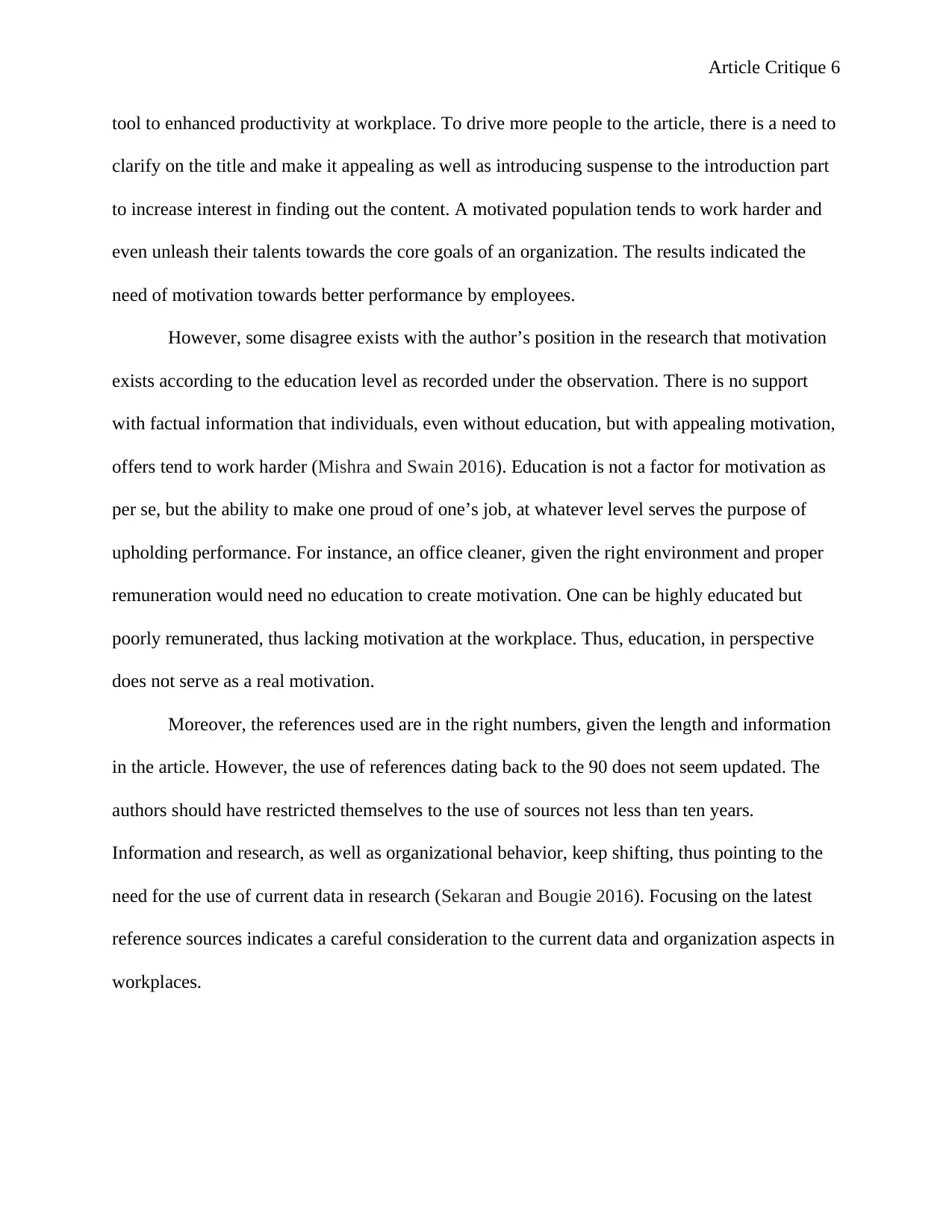
Article Critique 6
tool to enhanced productivity at workplace. To drive more people to the article, there is a need to
clarify on the title and make it appealing as well as introducing suspense to the introduction part
to increase interest in finding out the content. A motivated population tends to work harder and
even unleash their talents towards the core goals of an organization. The results indicated the
need of motivation towards better performance by employees.
However, some disagree exists with the author’s position in the research that motivation
exists according to the education level as recorded under the observation. There is no support
with factual information that individuals, even without education, but with appealing motivation,
offers tend to work harder (Mishra and Swain 2016). Education is not a factor for motivation as
per se, but the ability to make one proud of one’s job, at whatever level serves the purpose of
upholding performance. For instance, an office cleaner, given the right environment and proper
remuneration would need no education to create motivation. One can be highly educated but
poorly remunerated, thus lacking motivation at the workplace. Thus, education, in perspective
does not serve as a real motivation.
Moreover, the references used are in the right numbers, given the length and information
in the article. However, the use of references dating back to the 90 does not seem updated. The
authors should have restricted themselves to the use of sources not less than ten years.
Information and research, as well as organizational behavior, keep shifting, thus pointing to the
need for the use of current data in research (Sekaran and Bougie 2016). Focusing on the latest
reference sources indicates a careful consideration to the current data and organization aspects in
workplaces.
tool to enhanced productivity at workplace. To drive more people to the article, there is a need to
clarify on the title and make it appealing as well as introducing suspense to the introduction part
to increase interest in finding out the content. A motivated population tends to work harder and
even unleash their talents towards the core goals of an organization. The results indicated the
need of motivation towards better performance by employees.
However, some disagree exists with the author’s position in the research that motivation
exists according to the education level as recorded under the observation. There is no support
with factual information that individuals, even without education, but with appealing motivation,
offers tend to work harder (Mishra and Swain 2016). Education is not a factor for motivation as
per se, but the ability to make one proud of one’s job, at whatever level serves the purpose of
upholding performance. For instance, an office cleaner, given the right environment and proper
remuneration would need no education to create motivation. One can be highly educated but
poorly remunerated, thus lacking motivation at the workplace. Thus, education, in perspective
does not serve as a real motivation.
Moreover, the references used are in the right numbers, given the length and information
in the article. However, the use of references dating back to the 90 does not seem updated. The
authors should have restricted themselves to the use of sources not less than ten years.
Information and research, as well as organizational behavior, keep shifting, thus pointing to the
need for the use of current data in research (Sekaran and Bougie 2016). Focusing on the latest
reference sources indicates a careful consideration to the current data and organization aspects in
workplaces.
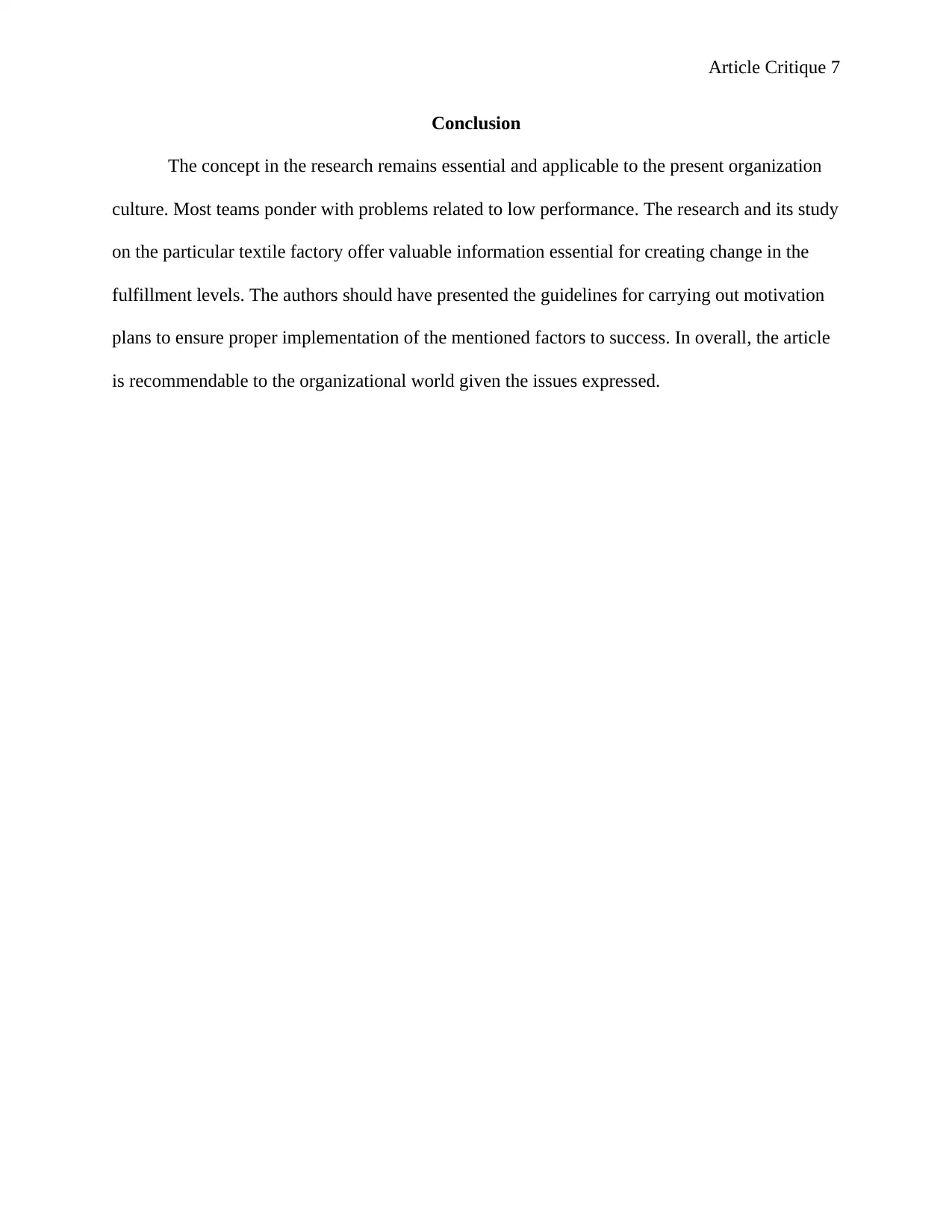
Article Critique 7
Conclusion
The concept in the research remains essential and applicable to the present organization
culture. Most teams ponder with problems related to low performance. The research and its study
on the particular textile factory offer valuable information essential for creating change in the
fulfillment levels. The authors should have presented the guidelines for carrying out motivation
plans to ensure proper implementation of the mentioned factors to success. In overall, the article
is recommendable to the organizational world given the issues expressed.
Conclusion
The concept in the research remains essential and applicable to the present organization
culture. Most teams ponder with problems related to low performance. The research and its study
on the particular textile factory offer valuable information essential for creating change in the
fulfillment levels. The authors should have presented the guidelines for carrying out motivation
plans to ensure proper implementation of the mentioned factors to success. In overall, the article
is recommendable to the organizational world given the issues expressed.
Paraphrase This Document
Need a fresh take? Get an instant paraphrase of this document with our AI Paraphraser
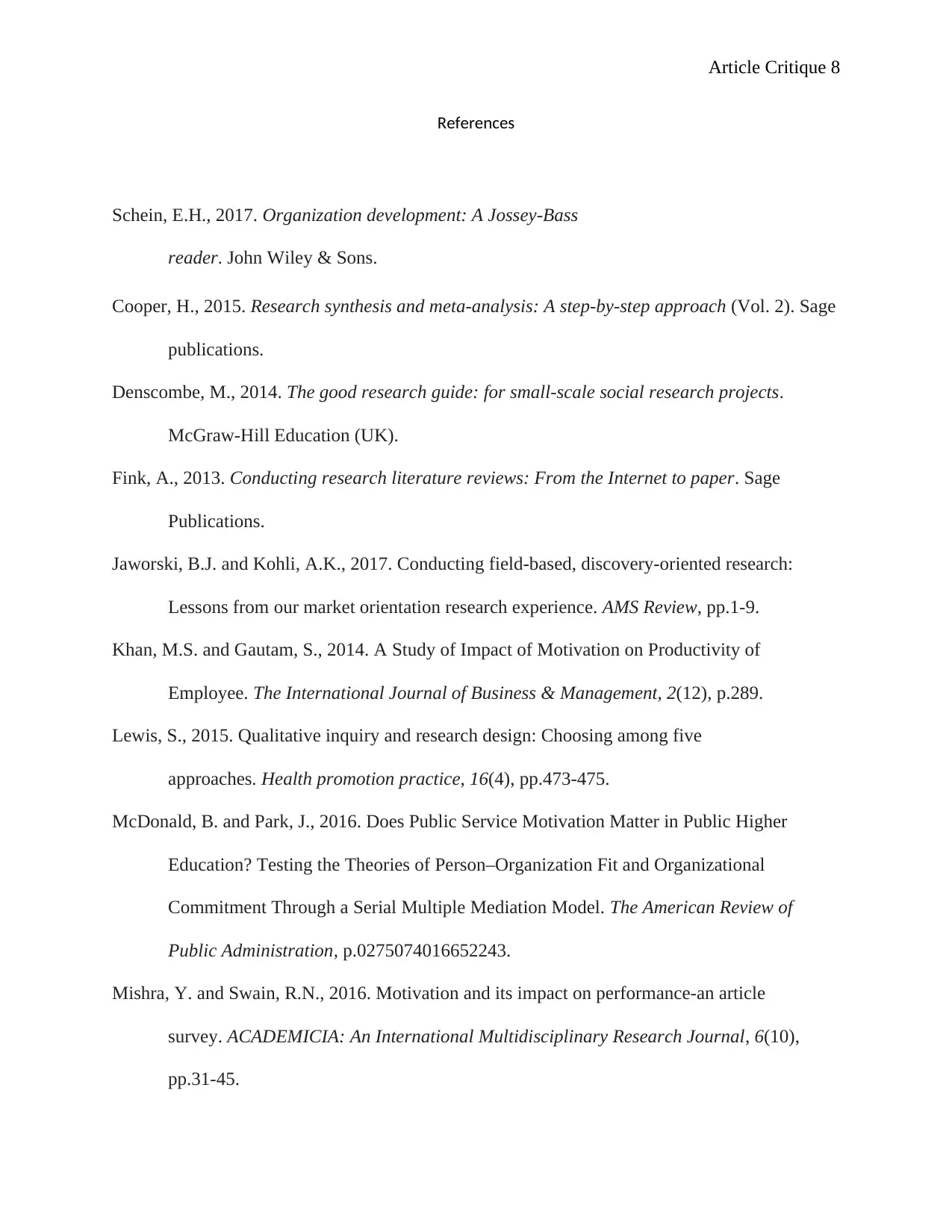
Article Critique 8
References
Schein, E.H., 2017. Organization development: A Jossey-Bass
reader. John Wiley & Sons.
Cooper, H., 2015. Research synthesis and meta-analysis: A step-by-step approach (Vol. 2). Sage
publications.
Denscombe, M., 2014. The good research guide: for small-scale social research projects.
McGraw-Hill Education (UK).
Fink, A., 2013. Conducting research literature reviews: From the Internet to paper. Sage
Publications.
Jaworski, B.J. and Kohli, A.K., 2017. Conducting field-based, discovery-oriented research:
Lessons from our market orientation research experience. AMS Review, pp.1-9.
Khan, M.S. and Gautam, S., 2014. A Study of Impact of Motivation on Productivity of
Employee. The International Journal of Business & Management, 2(12), p.289.
Lewis, S., 2015. Qualitative inquiry and research design: Choosing among five
approaches. Health promotion practice, 16(4), pp.473-475.
McDonald, B. and Park, J., 2016. Does Public Service Motivation Matter in Public Higher
Education? Testing the Theories of Person–Organization Fit and Organizational
Commitment Through a Serial Multiple Mediation Model. The American Review of
Public Administration, p.0275074016652243.
Mishra, Y. and Swain, R.N., 2016. Motivation and its impact on performance-an article
survey. ACADEMICIA: An International Multidisciplinary Research Journal, 6(10),
pp.31-45.
References
Schein, E.H., 2017. Organization development: A Jossey-Bass
reader. John Wiley & Sons.
Cooper, H., 2015. Research synthesis and meta-analysis: A step-by-step approach (Vol. 2). Sage
publications.
Denscombe, M., 2014. The good research guide: for small-scale social research projects.
McGraw-Hill Education (UK).
Fink, A., 2013. Conducting research literature reviews: From the Internet to paper. Sage
Publications.
Jaworski, B.J. and Kohli, A.K., 2017. Conducting field-based, discovery-oriented research:
Lessons from our market orientation research experience. AMS Review, pp.1-9.
Khan, M.S. and Gautam, S., 2014. A Study of Impact of Motivation on Productivity of
Employee. The International Journal of Business & Management, 2(12), p.289.
Lewis, S., 2015. Qualitative inquiry and research design: Choosing among five
approaches. Health promotion practice, 16(4), pp.473-475.
McDonald, B. and Park, J., 2016. Does Public Service Motivation Matter in Public Higher
Education? Testing the Theories of Person–Organization Fit and Organizational
Commitment Through a Serial Multiple Mediation Model. The American Review of
Public Administration, p.0275074016652243.
Mishra, Y. and Swain, R.N., 2016. Motivation and its impact on performance-an article
survey. ACADEMICIA: An International Multidisciplinary Research Journal, 6(10),
pp.31-45.
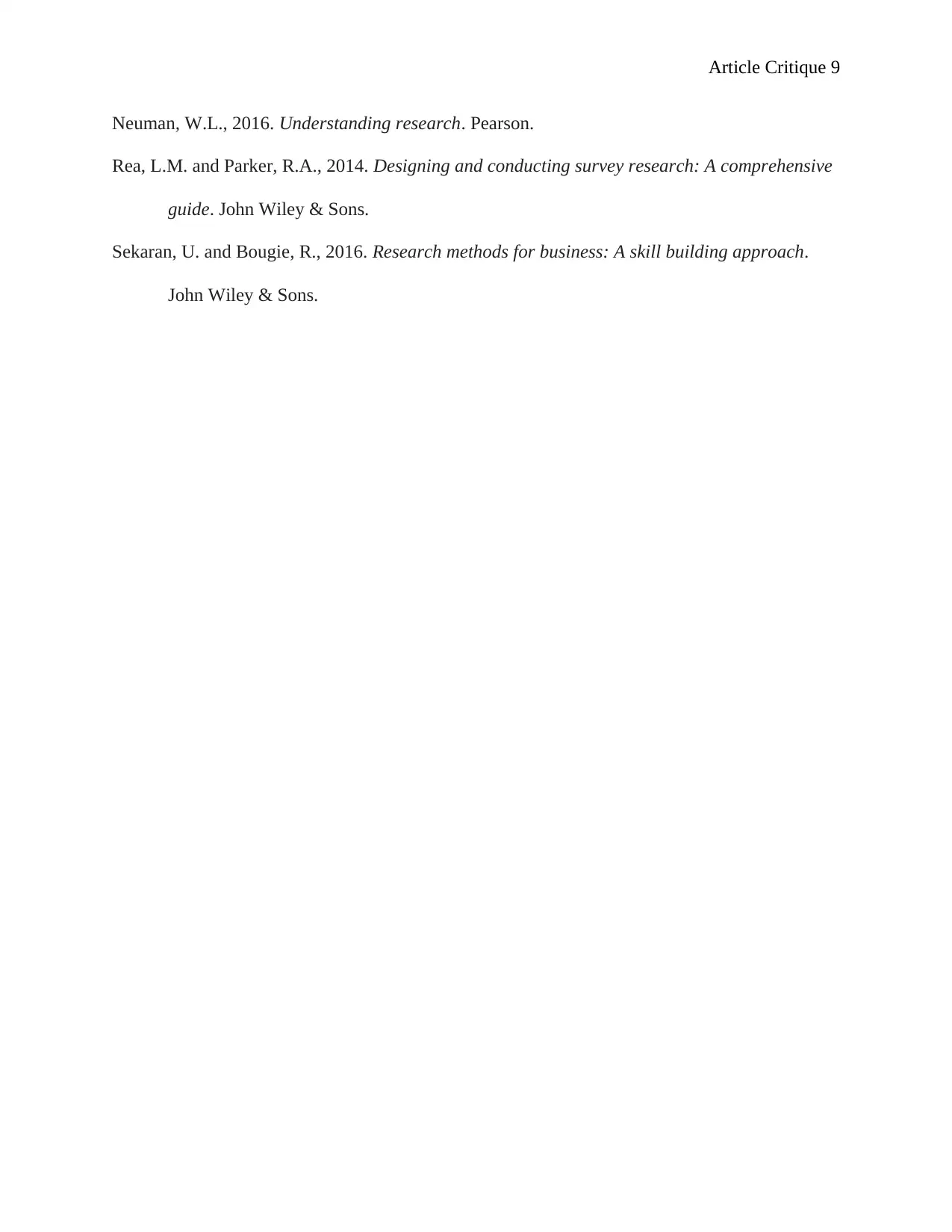
Article Critique 9
Neuman, W.L., 2016. Understanding research. Pearson.
Rea, L.M. and Parker, R.A., 2014. Designing and conducting survey research: A comprehensive
guide. John Wiley & Sons.
Sekaran, U. and Bougie, R., 2016. Research methods for business: A skill building approach.
John Wiley & Sons.
Neuman, W.L., 2016. Understanding research. Pearson.
Rea, L.M. and Parker, R.A., 2014. Designing and conducting survey research: A comprehensive
guide. John Wiley & Sons.
Sekaran, U. and Bougie, R., 2016. Research methods for business: A skill building approach.
John Wiley & Sons.
1 out of 9
Related Documents
Your All-in-One AI-Powered Toolkit for Academic Success.
+13062052269
info@desklib.com
Available 24*7 on WhatsApp / Email
![[object Object]](/_next/static/media/star-bottom.7253800d.svg)
Unlock your academic potential
© 2024 | Zucol Services PVT LTD | All rights reserved.




